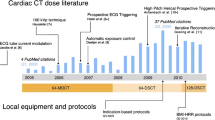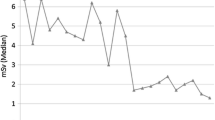Abstract
Objectives
We investigated the potential reduction of patient exposure during invasive coronary angiography (ICA) if the procedure had only been directed to the vessel with at least one ≥ 50% stenosis as described in the CT report.
Methods
Dose reports of 61 patients referred to ICA because of at least one ≥ 50% stenosis on coronary CT angiography (CCTA) were included. Dose–area product (DAP) was documented separately for left (LCA) and right coronary arteries (RCA) by summing up the single DAP for each angiographic projection. The study population was subdivided as follows: coronary intervention of LCA (group 1) or RCA (group 2) only, or of both vessels (group 3), or further bypass grafting (group 4), or no further intervention (group 5).
Results
57.4% of the study population could have benefitted from reduced exposure if catheterization had been directly guided to the vessel of interest as described on CCTA. Mean relative DAP reductions were as follows: group 1 (n = 18), 11.2%; group 2 (n = 2), 40.3%; group 3 (n = 10), 0%; group 4 (n = 3), 0%; group 5 (n = 28), 28.8%.
Conclusions
Directing ICA to the vessel with stenosis as described on CCTA would reduce intraprocedural patient exposure substantially, especially for patients with single-vessel stenosis.
Key points
• Patients with CAD can benefit from decreased radiation exposure during coronary angiography.
• ICA should be directed solely to significant stenoses as described on CCTA.
• Severely calcified plaques remain a limitation of CCTA leading to unnecessary ICA referrals.

Similar content being viewed by others
Abbreviations
- CABG:
-
Coronary artery bypass grafting
- CAD:
-
Coronary artery disease
- CCTA:
-
Coronary computed tomography angiography
- DAP:
-
Dose–area product
- DLP:
-
Dose–length product
- FFR:
-
Fractional flow reserve
- ICA:
-
Invasive coronary angiography
- LCA:
-
Left coronary artery
- PCI:
-
Percutaneous coronary intervention
- RCA:
-
Right coronary artery
References
Taylor AJ, Cerqueira M, Hodgson JM et al (2010) ACCF/SCCT/ACR/AHA/ASE/ASNC/NASCI/SCAI/SCMR 2010 Appropriate Use Criteria for Cardiac Computed Tomography. A report of the American College of Cardiology Foundation Appropriate Use Criteria Task Force, the Society of Cardiovascular Computed Tomography, the American College of Radiology, the American Heart Association, the American Society of Echocardiography, the American Society of Nuclear Cardiology, the North American Society for Cardiovascular Imaging, the Society for Cardiovascular Angiography and Interventions, and the Society for Cardiovascular Magnetic Resonance. J Cardiovasc Comput Tomogr 4:407 e1–407 33
von Ballmoos MW, Haring B, Juillerat P, Alkadhi H (2011) Meta-analysis: diagnostic performance of low-radiation-dose coronary computed tomography angiography. Ann Intern Med 154:413–420
Kim HY, Choi JH (2015) How to utilize coronary computed tomography angiography in the treatment of coronary artery disease. J Cardiovasc Ultrasound 23:204–208
Montalescot G, Sechtem U, Achenbach S et al (2013) 2013 ESC guidelines on the management of stable coronary artery disease: the Task Force on the management of stable coronary artery disease of the European Society of Cardiology. Eur Heart J 34:2949–3003
Teunen D (1998) The European Directive on health protection of individuals against the dangers of ionising radiation in relation to medical exposures (97/43/EURATOM). J Radiol Prot 18:133–137
Ghoshhajra BB, Engel LC, Major GP et al (2012) Evolution of coronary computed tomography radiation dose reduction at a tertiary referral center. Am J Med 125:764–772
De Cecco CN, Meinel FG, Chiaramida SA, Costello P, Bamberg F, Schoepf UJ (2014) Coronary artery computed tomography scanning. Circulation 129:1341–1345
Achenbach S, Marwan M, Ropers D et al (2010) Coronary computed tomography angiography with a consistent dose below 1 mSv using prospectively electrocardiogram-triggered high-pitch spiral acquisition. Eur Heart J 31:340–346
Bogaert E, Bacher K, Thierens H (2008) A large-scale multicentre study in Belgium of dose area product values and effective doses in interventional cardiology using contemporary X-ray equipment. Radiat Prot Dosimetry 128:312–323
Betsou S, Efstathopoulos EP, Katritsis D, Faulkner K, Panayiotakis G (1998) Patient radiation doses during cardiac catheterization procedures. Br J Radiol 71:634–639
Picano E, Santoro G, Vano E (2007) Sustainability in the cardiac cath lab. Int J Cardiovasc Imaging 23:143–147
Goldstein JA, Balter S, Cowley M, Hodgson J, Klein LW (2004) Occupational hazards of interventional cardiologists: prevalence of orthopedic health problems in contemporary practice. Catheter Cardiovasc Interv 63:407–411
Andreassi MG, Piccaluga E, Guagliumi G, Del Greco M, Gaita F, Picano E (2016) Occupational health risks in cardiac catheterization laboratory workers. Circ Cardiovasc Interv 9:e003273
Rajiah P, Schoenhagen P (2013) The role of computed tomography in pre-procedural planning of cardiovascular surgery and intervention. Insights Imaging 4:671–689
Patel MR, Bailey SR, Bonow RO et al (2012) ACCF/SCAI/AATS/AHA/ASE/ASNC/HFSA/HRS/SCCM/SCCT/SCMR/STS 2012 appropriate use criteria for diagnostic catheterization: a report of the American College of Cardiology Foundation Appropriate Use Criteria Task Force, Society for Cardiovascular Angiography and Interventions, American Association for Thoracic Surgery, American Heart Association, American Society of Echocardiography, American Society of Nuclear Cardiology, Heart Failure Society of America, Heart Rhythm Society, Society of Critical Care Medicine, Society of Cardiovascular Computed Tomography, Society for Cardiovascular Magnetic Resonance, and Society of Thoracic Surgeons. J Am Coll Cardiol 59:1995–2027
Plank F, Friedrich G, Dichtl W et al (2014) The diagnostic and prognostic value of coronary CT angiography in asymptomatic high-risk patients: a cohort study. Open Heart 1:e000096
Arbab-Zadeh A, Miller JM, Rochitte CE et al (2012) Diagnostic accuracy of computed tomography coronary angiography according to pre-test probability of coronary artery disease and severity of coronary arterial calcification. The CORE-64 (Coronary Artery Evaluation Using 64-Row Multidetector Computed Tomography Angiography) International Multicenter Study. J Am Coll Cardiol 59:379–387
Budoff MJ, Dowe D, Jollis JG et al (2008) Diagnostic performance of 64-multidetector row coronary computed tomographic angiography for evaluation of coronary artery stenosis in individuals without known coronary artery disease: results from the prospective multicenter ACCURACY (Assessment by Coronary Computed Tomographic Angiography of Individuals Undergoing Invasive Coronary Angiography) trial. J Am Coll Cardiol 52:1724–1732
Carrascosa P, Capunay C, Deviggiano A et al (2010) Accuracy of low-dose prospectively gated axial coronary CT angiography for the assessment of coronary artery stenosis in patients with stable heart rate. J Cardiovasc Comput Tomogr 4:197–205
Mangold S, Wichmann JL, Schoepf UJ et al (2017) Diagnostic accuracy of coronary CT angiography using 3rd-generation dual-source CT and automated tube voltage selection: Clinical application in a non-obese and obese patient population. Eur Radiol 27:2298–2308
Engel LC, Thai WE, Medina-Zuluaga H et al (2017) Non-diagnostic coronary artery calcification and stenosis: a correlation of coronary computed tomography angiography and invasive coronary angiography. Acta Radiol 58:528–536
Dey D, Lee CJ, Ohba M et al (2008) Image quality and artifacts in coronary CT angiography with dual-source CT: initial clinical experience. J Cardiovasc Comput Tomogr 2:105–114
Andrew M, John H (2015) The challenge of coronary calcium on coronary computed tomographic angiography (CCTA) scans: effect on interpretation and possible solutions. Int J Cardiovasc Imaging 31:145–157
Compagnone G, Ortolani P, Domenichelli S et al (2011) Effective and equivalent organ doses in patients undergoing coronary angiography and percutaneous coronary intervention. Med Phys 38:2168–2175
Kerl JM, Schoepf UJ, Zwerner PL et al (2011) Accuracy of coronary artery stenosis detection with CT versus conventional coronary angiography compared with composite findings from both tests as an enhanced reference standard. Eur Radiol 21:1895–1903
Funding
The authors state that this work has not received any funding.
Author information
Authors and Affiliations
Corresponding author
Ethics declarations
Guarantor
The scientific guarantor of this publication is Ralf W. Bauer.
Conflict of interest
The authors of this manuscript declare relationships with the following companies:
Ralf W. Bauer is on the speakers’ bureau of Siemens Healthcare, Bayer Healthcare and GE Healthcare. Julian L. Wichmann received speakers’ fees from Siemens Healthcare and GE Healthcare.
Statistics and biometry
One of the authors has significant statistical expertise.
No complex statistical methods were necessary for this paper.
Informed consent
Written informed consent was waived by the institutional review board.
Ethical approval
Institutional review board approval was obtained.
Methodology
• retrospective
• observational
• performed at one institution
Rights and permissions
About this article
Cite this article
Arendt, C.T., Tischendorf, P., Wichmann, J.L. et al. Using coronary CT angiography for guiding invasive coronary angiography: potential role to reduce intraprocedural radiation exposure. Eur Radiol 28, 2756–2762 (2018). https://doi.org/10.1007/s00330-018-5317-2
Received:
Revised:
Accepted:
Published:
Issue Date:
DOI: https://doi.org/10.1007/s00330-018-5317-2




